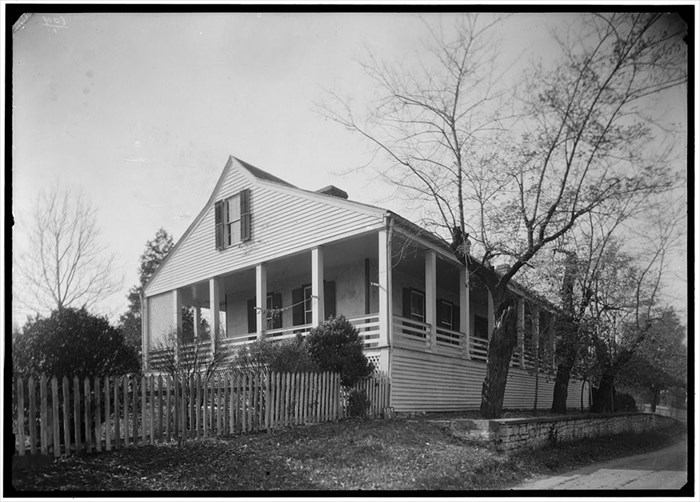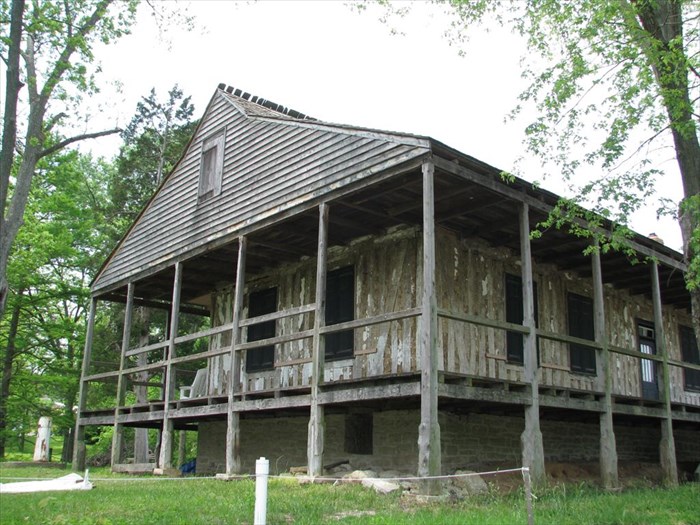

"Nicolas Janis House. Local names: Green Tree Tavern, Janis-Ziegler
House. 241 St. Mary's Road. c. 1790-1791. HABS No.: MO-1104. Property type:
French vertical log house. As Jack Luer and Jesse Francis note, in this house
the blend of the traditional French poteaux sur sole/bousillage
construction and the American desire for comfort and privacy is evident. The
cuisine d' été (free standing kitchen) and
four de terre (free standing exterior bake oven) were abandoned in favor of the
Anglo kitchen with its massive cooking fireplace. Individual rooms were provided
for privacy and sleeping. Each room had its own fireplace. Federal style details
including doors, mantels, double-hung windows, and millwork were used, and brick
was the preferred material for chimneys. A roof with gable ends enclosed the
attic, and a permanent stairway made the attic more accessible. A raised
basement provided housing for slaves at one end and a secure storeroom at the
other. These American spatial and functional concepts are combined with the
traditional French poteaux sur sole/bousillage construction, roof overhangs
shading the wall for comfort, and a family dwelling and business under the same
roof.
Unlike typical French houses, the roof has pegged rafters rather than
trusses. According to dendrochronological investigation, tested roof members
were cut in 1808. These members may have replaced portions of the original
framing, because documentary evidence points to a late eighteenth century
construction date. The house, which measures 73 feet 6 inches across the front
by 39 feet 9 inches deep, is a large example of vertical log construction on a
raised, random cut, stone foundation. The walls are hewn, white oak logs,
mortised into a sill, infilled with bouzillage. The west wall was
sheathed with horizontal clapboards over nogging. Both gable ends were also
sheathed in horizontal clapboards. The hand-hewn, pine roof rafters with
vertically sawn collar beams are spaced about two feet on center. A typical
French colonial gallery extends along three sides of the house. The gallery has
red cedar posts. Secondary rafters extend over the gallery giving the
characteristic double pitch to the roof. The gable ends of the building are
sheathed in clapboards and are fenestrated with six-over-six, double hung
windows. More than 90 percent of the original interior woodwork remains.
The house's plan is typical of large French colonial homes with a major
central room flanked by three smaller rooms on one side and two smaller rooms on
the other side. The house has an unusual triangular chimney and clear evidence
for a second one that does not survive above the basement level. Evidence of the
relocation of the stairway is also clear. The house contains the most unaltered
interior of any surviving Creole house in Ste. Genevieve. Many interesting early
details survive including doors, windows, shutters, hardware, and three Federal
style mantels.
Changes were made to the building during its construction. After the
foundation and log walls were in place but before the gallery deck or roof
framing was installed, the west gallery and southwest corner of the south
gallery were enclosed as two cabinets with rough hewn willow studs for the
exterior walls. A transitional roof with gabled end walls extending over the end
galleries replaced the planned hip roof.
The house has had few alterations. The most extensive alterations occurred in
1800. The triangular-shaped chimney with its two fireplaces and oven was removed
from the west end. The door between the kitchen and tavern has been changed to a
cased opening, the interior walls of the original cabinets have had doors added,
three new brick stove flues were also added, and in the trading room in the
center of the building, a replacement boxed stair was added. The mantelpieces
are of the Federal period and were probably additions. Several porch posts
display early carvings. On the left post as one faces the trade room door, one
can see the carved initials, "FJ," i.e. "Francois Janis." On the post to the
right of this is carved "H Janis," the name of one of Francois' sons. Two other
posts display Masonic emblems.
In the late eighteenth century, the house was sited above the level of St.
Mary's Road. A limestone retaining wall extended along the edge of the property.
This wall still exists but is presently hidden by the raised road. The house was
inundated during the 1993 flood. As a result, it suffered significant damage.
Restoration has been underway for the several years with the goal of returning
the exterior and much of the interior as possible to its historic appearance.
Presently, the clapboards that formerly clad the house have been removed, as has
the enclosure of the crawlspace. The house retains a large amount of its
historic fabric, and the ongoing restoration seeks to replicate missing elements
of the original fabric.
The site of the house was part of U.S. Survey 352, originally confirmed to
Jean Baptiste LaBreche in 1789. This property was acquired in the same year by
Nicolas Janis when it was described as "LaBreche's Cow Pasture." It was
transferred, with a house on it, to his son Francois in 1796.36 In 1803,
Francois entered into a contract for the stone wall across the front of the
property. About the same time, he began to operate the Greentree Tavern in the
house. On April 20, 1833, Francois's heirs sold it to Mathias Ziegler. The
property remained in Ziegler family ownership for 105 years. It was later opened
as a house museum. The house was documented in 1985 by a HABS team under the
direction of Professor Osmund Overby of the University of Missouri.
Nicolas Janis spent the first portion of his adult life in Kaskaskia. He
married Susanne LaSource at Kaskaskia in 1751. The marriage produced four
children: Francois, Jean-Baptiste, Antoine, and Felicité. The latter
married Vital St. Gemme Beauvais in 1775." ~
Historic District National Register Nomination Form